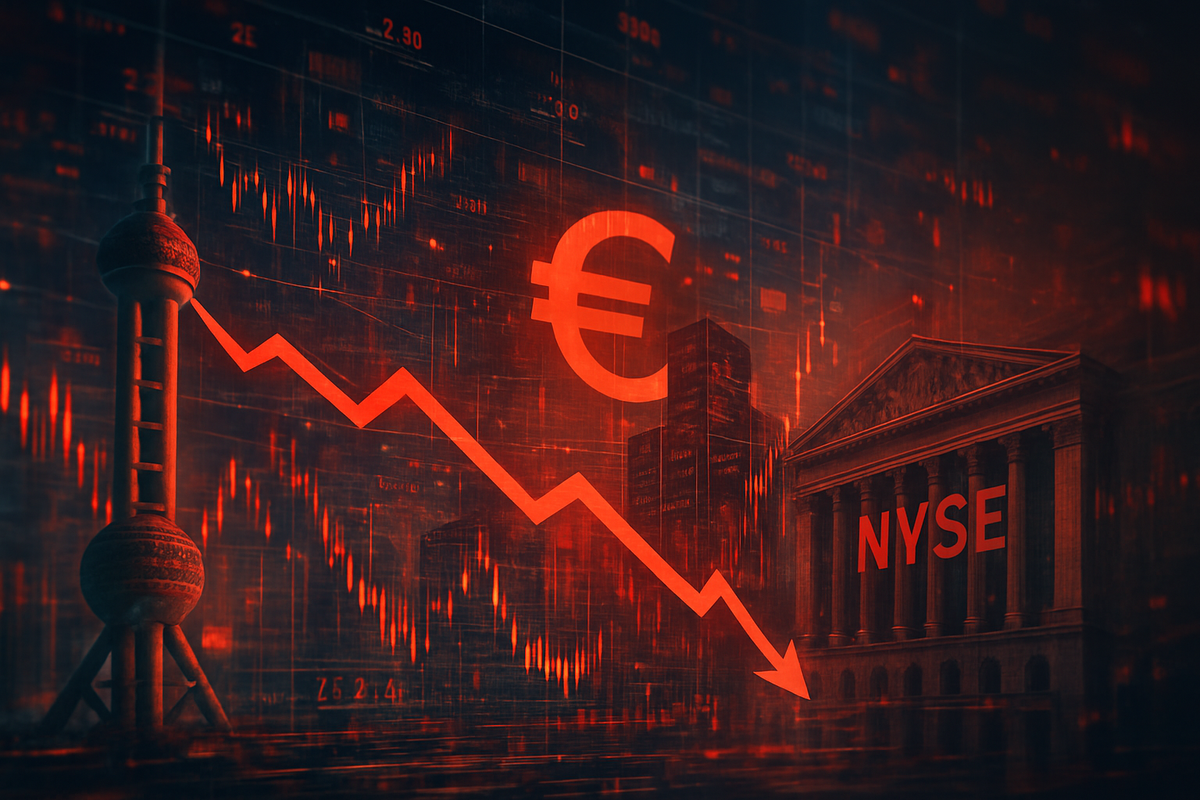Global Markets Brace for Turbulence as Volatility Surges: Implications for Asian and European Investors

Global stock markets are currently experiencing a significant surge in volatility, a stark contrast to any easing trends, as investors grapple with a complex web of economic uncertainties and geopolitical tensions. As of November 19, 2025, the CBOE Volatility Index (VIX), often dubbed the "fear gauge," has seen a notable increase, signaling heightened investor anxiety and an expectation of continued market turbulence. This turbulent landscape presents immediate challenges and necessitates a reassessment of strategies for investors, particularly those navigating the intricate dynamics of Asian and European markets.
Unpacking the Surge: Factors Fueling Market Jitters
The current escalation in market volatility is not an isolated event but rather the culmination of several potent factors that have converged to create a challenging environment for global equities. The VIX index, a key barometer of market sentiment, has been trading at elevated levels, with reports indicating a spot price of $23.78 on November 19, 2025, and an intra-day spike to 52.87 on November 18, settling at 48.35 by market close. This signifies widespread investor nervousness and a bracing for larger price swings across major indices. The S&P 500 (SPX) is notably down more than 3% this month, on track for its worst November since 2008.
A primary driver behind this intensified turbulence is the pervasive concern over potentially overvalued technology stocks, especially those within the booming artificial intelligence (AI) sector. Investors are actively re-evaluating asset prices and questioning the sustainability of current stock levels. The highly anticipated earnings report from AI behemoth Nvidia (NASDAQ: NVDA) is a significant event being closely watched by market participants, capable of swaying sentiment further. Compounding these valuation concerns is the uncertainty surrounding central bank policies. Fading expectations of near-term interest rate cuts by the U.S. Federal Reserve are weighing heavily on risk assets, even as the European Central Bank (ECB) and the Bank of England (BoE) initiated rate reductions earlier in 2025. The Fed's cautious stance has diminished the probability of a December rate cut, creating a divergence in monetary policy expectations that adds to market jitters.
Furthermore, a series of macroeconomic headwinds and escalating geopolitical tensions are shaping a cautious global economic outlook. Lingering inflation, coupled with rising protectionism, including new U.S. tariff policies, contributes to a cautious sentiment. Weak U.S. employment data has sparked fears of a potential recession, while China continues to battle internal challenges such as subdued retail sales, weak consumer sentiment, and persistent issues within its property sector. These global pressures collectively foster an environment of risk aversion, leading to a notable flight to perceived safer assets, such as U.S. Treasuries, and a significant decline in cryptocurrencies, with Bitcoin (BTC) notably falling below $90,000 as risk appetite dwindled.
Companies Navigating the Choppy Waters: Winners and Losers
In an environment of heightened volatility, certain companies and sectors in Asian and European markets are likely to experience disproportionate impacts, creating distinct winners and losers. The current "risk-off" sentiment typically favors defensive sectors and companies with strong balance sheets and consistent earnings, while growth-oriented and highly leveraged firms may face headwinds.
In Europe, sectors traditionally considered defensive, such as utilities, consumer staples, and healthcare, may see increased investor interest as a safe haven amidst the storm. Companies like Nestlé (SWX: NESN), Unilever (AMS: UNA), and major pharmaceutical firms could benefit from their stable demand and pricing power. Conversely, European technology stocks and cyclical industries heavily reliant on consumer spending or industrial output may suffer. While some analyses suggest a "meaningful resurgence" in capital flows into European markets over the past year, particularly into domestically focused sectors, the current global uncertainty could temper this enthusiasm. Firms with significant exposure to global trade or those heavily invested in capital-intensive projects might face delays or reduced profitability.
Asian markets are similarly segmented. While the broader market has mirrored global downturns, some emerging markets, including those in Asia, are projected by some analyses to perform strongly in 2026 due to fundamental strengths and attractive valuations. However, in the immediate term, companies heavily reliant on export markets, particularly those impacted by U.S.-China trade tensions or a global economic slowdown, could struggle. Tech companies in South Korea (e.g., Samsung Electronics, KRX: 005930) and Taiwan (e.g., TSMC, TWSE: 2330), while fundamentally strong, could see their valuations pressured by broader AI valuation concerns and a shift away from growth stocks. On the other hand, companies in sectors like renewable energy or those with strong domestic demand in resilient Asian economies might show greater stability. Investors are likely to favor companies with robust cash flows and those less susceptible to global supply chain disruptions or sudden shifts in consumer sentiment.
Wider Significance: A Shift in Market Paradigm
The current surge in global stock market volatility signifies more than just a temporary blip; it reflects a potential shift in the broader industry landscape, moving away from a prolonged period of relatively low interest rates and stable growth. This heightened uncertainty fits into broader trends of economic re-evaluation, where the long-term implications of elevated public debt, persistent inflation, and geopolitical fragmentation are becoming increasingly apparent. The market's reaction to AI valuation concerns, for instance, highlights a maturing phase for the technology sector, where speculative growth may give way to a greater emphasis on tangible profitability and sustainable business models.
The ripple effects of this volatility extend beyond individual companies, impacting competitors and partners across various supply chains. Companies reliant on stable capital markets for financing or expansion may find it more challenging to secure funds or face higher borrowing costs. Furthermore, the increased risk aversion could lead to a slowdown in mergers and acquisitions activity, as firms become more cautious about strategic investments. Regulatory bodies and policymakers will also be closely monitoring the situation. A sustained period of high volatility could prompt discussions around market stability mechanisms, investor protection, and even a re-evaluation of monetary policy frameworks, especially if economic growth significantly falters. Historically, periods of elevated volatility have often preceded or accompanied economic downturns, serving as a warning signal that warrants careful attention from both market participants and regulators. The current environment echoes past instances of market corrections driven by overvaluation concerns or shifts in central bank policy, reminding investors of the cyclical nature of financial markets.
What Comes Next: Navigating the Unpredictable Path
Looking ahead, the short-term outlook suggests a continuation of the current volatile environment, with market participants closely monitoring key economic indicators, central bank communications, and geopolitical developments. The upcoming earnings reports from major technology companies, particularly Nvidia, will be crucial in shaping investor sentiment regarding AI valuations. Any unexpected hawkish signals from the U.S. Federal Reserve could further exacerbate market jitters, while clearer indications of a dovish pivot might provide some relief.
In the long term, this period of heightened volatility could force strategic pivots and adaptations across industries. Companies may prioritize operational efficiency, strengthen their balance sheets, and diversify their revenue streams to build resilience against future shocks. For investors, this environment presents both challenges and opportunities. While the immediate impulse might be to retreat, periods of correction can offer attractive entry points for long-term investors in fundamentally sound companies that have been oversold. Active traders, adept at navigating choppy markets, may find increased opportunities for short-term gains. Potential scenarios range from a continued market correction, particularly if inflation persists and central banks remain hawkish, to a gradual stabilization once key uncertainties subside and valuations become more attractive. Investors should prepare for a landscape where robust risk management, strategic asset allocation, and a focus on quality investments become paramount.
Comprehensive Wrap-up: A New Era of Market Prudence
The current surge in global stock market volatility, far from an easing trend, marks a significant shift in the financial landscape, demanding a heightened level of prudence and strategic foresight from investors. Key takeaways include the critical impact of AI valuation concerns, the lingering uncertainty surrounding central bank monetary policies, and the pervasive influence of macroeconomic headwinds and geopolitical tensions. These factors have collectively fueled a "risk-off" sentiment, leading to a flight to safety and a re-evaluation of investment portfolios.
Moving forward, the market is likely to remain dynamic and unpredictable. Investors should be prepared for continued price swings and potential corrections. The emphasis will be on identifying resilient companies with strong fundamentals, healthy balance sheets, and consistent earnings, particularly in defensive sectors. Diversification across geographies and asset classes will be crucial in mitigating risk. What investors should watch for in the coming months includes the trajectory of inflation, the future path of interest rates from major central banks, and any significant developments in geopolitical hotspots. The earnings performance of key technology players will also provide vital clues about the sustainability of current valuations. This period, while challenging, also offers an opportunity for investors to refine their strategies, focus on long-term value, and emerge stronger from the turbulence.
This content is intended for informational purposes only and is not financial advice



